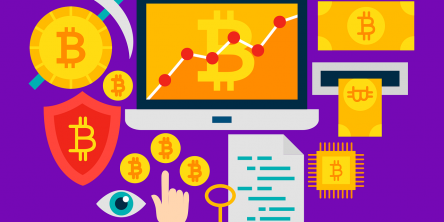The History of Ethereum: Main events that changed the evolution of ETH

Ethereum is a digital ledger that has leveraged the potential of blockchain technology, such as integrating decentralization. Ethereum has revolutionized this technology, as it focused on the integration of smart contracts, which execute themselves when they meet the conditions written in the code. The native coin of Ethereum is Ether (ETH), the second largest cryptocurrency by market cap, which powers the Ethereum blockchain.
Ether is among the favorite options when investors want to add digital coins to their portfolios. The ETH price prediction shows that the value of this digital coin can increase in the future, which makes investing in this cryptocurrency an even better idea.
In this article, we will discover more about Ethereum, so keep reading.
The evolution of Ethereum: The early days
Vitalik Buterin came up with the idea of Ethereum when he noticed that Bitcoin had some shortcomings. As a result, he published a white paper in November 2013 explaining the concept of Ethereum. The project attracted more attention, and a large team of many members decided to make the idea of Ethereum a reality.
To have the funding to launch this project, the co-founders of this digital coin considered an Initial Coin Offering (ICO). Ethereum went live on July 30, 2015.
The upgrades and changes of Ethereum
Even though Ethereum was launched in 2015, it took longer for this digital coin to become the updated blockchain we know and appreciate nowadays. This is why the evolution of Ethereum was lengthy, and it met various changes along the way. Some of the most important upgrades for Ethereum were Constantinople, Byzantium, and the Beacon Chain, which all improved its limitations.
Byzantium and Constantinople update
The Byzantium and Constantinople updates were very important in the evolution of Ethereum, as they introduced better features that improved its stability, scalability, and security. For instance, the Byzantium upgrade added mathematical operations for the Ethereum Virtual Machine (EVM). The Constantinople update was also crucial for the evolution of Ethereum, integrating Ethereum Improvement Proposals (EIPs), where users can propose new improvements and direction for Ethereum.
Thanks to both these updates, Ethereum has managed to achieve faster transaction speeds and increased dApp usage.
Beacon Chain update
The Beacon Chain was also an important update for Ethereum when this digital ledger transitioned from the incipient phase to Ethereum 2.0. Thanks to this upgrade, Ethereum integrated new features, such as sharding and staking, thus improving its scalability and network speed. Ethereum grew in popularity over the years, and it needed to improve its operations to be able to host more users.
Additionally, in the Beacon Chain update, Ethereum started the transition to a Proof-Of-Stake (PoS) consensus mechanism. When it was first launched, Ethereum used a Proof-of-Work (PoW) consensus mechanism, but because of its high cost and electrical consumption, it moved to a PoS model.
The Dao Hack
Decentralized autonomous organization (DAO) was an interesting concept for Ethereum. One type of DAO that influenced the Ethereum platform was "The DAO." This has benefited from a lot of attention, raising a large amount of money to be one of the largest crowdfunding campaigns. It wanted to utilize smart contracts to facilitate decision-making and investment without involving intermediaries.
However, this DAO met one big obstacle on the way because it suffered a massive hack in June 2016. The community of Ethereum was in shock, and this event caused a lot of trouble and chaos, with the hack having a loss of over $50 million of Ether. The community of Ethereum needed to offer their opinion on the outcome of this tragic event and to say whether they should continue to use the same platform or make two separate digital ledgers.
To solve the situation, Ethereum underwent a hard fork and separated the blockchains into Ethereum and Ethereum Classic. Although most agreed with this decision, some said it was against the notion of blockchain, which should always focus on immutability. Ethereum Classic is the original version of Ethereum, while Ethereum is the forked blockchain.
What are the upgrades for the future?
In the future, Ethereum can experience more upgrades that can improve its blockchain even more. The Pectra upgrade is one of those that can enhance the efficiency, scalability, and usability of Ethereum even more. Pectra wants to increase the capacity for more layer-2 solutions. At the same time, another focus of this upgrade is to reduce fees. The flexible gas payments are a way in which Pectra wishes to improve Ethereum.
Pectra also introduces account abstraction, where individuals can pay fees using ERC-20-built tokens. In this way, they are not restricted only to ETH, which simplifies some things. The Verkle Trees is another great improvement of the Pectra upgrade, combining the Merkle Trees and Vector Commitments and offering more data storage for Ethereum.
The Pectra upgrade can bring several advantages to the Ethereum community, such as new recovery options, transaction batching, and new wallet types. This can eliminate fees and introduce new wallets that can improve Ethereum's usability and accessibility, thus enhancing efficiency and reducing costs.
The bottom line
Ethereum is among the most essential blockchains, and it owns the second-largest cryptocurrency by market cap. So, it is quite normal for this digital coin to need to go through many improvements to enhance its features. Ethereum wasn't launched with all the features it has today, but it was built through several updates that made this blockchain the important and powerful force we know today. In the future, Ethereum will surely continue to do what it takes to still represent a viable solution and offer users what they are looking for.
This applies even more today when the competition is fierce, and new projects are trying to overcome the shortcomings of the previous ones to amaze users with their features. Luckily, Ethereum does what it takes to remain relevant.
Similar Articles
Transfers on popular routes like SWIFT can take 1 to 5 business days or longer if there’s more than one middleman bank involved, and in case you’re wondering who pays, it’s up to you.
The cryptocurrency landscape has undergone a tremendous transformation in 2025, making it feel as though there is simply too much to encompass.
What are the best crypto staking coins and other digital assets to use in 2025 to get the desired profit in the investment process, and not lose your investments? Learn tips from experts and use them in practice
Thinking of trading meme coins? Learn how to spot hype early, avoid rugs, and play the game without getting wrecked. Straight talk, no fluff.
Cryptocurrencies are still a relatively new addition to the financial world, but that doesn’t mean they haven’t become popular among a large number of investors from all over the world who are looking to add them to their portfolios.
Can you actually buy a house with Bitcoin? Yup, you totally can, but it kind of depends on the seller. Some sellers and real estate agents are all for crypto and will accept Bitcoin directly.
Overall, mining containers have emerged as an innovative solution for the deployment of cryptocurrency mining operations. These mobile units are designed to house high-performance mining equipment, providing a flexible and scalable alternative to traditional mining facilities.
Many people who invested in cryptocurrencies like Bitcoin have made good money over the years, with some even benefiting from the rising Ai16z price trends in the market.
Cryptocurrencies are well-known among investors for their volatility and fluctuations. Sometimes, values can vary quite a lot, even in the span of a day, which is why many traders have been reluctant to adopt digital assets and include them in their list of holdings









